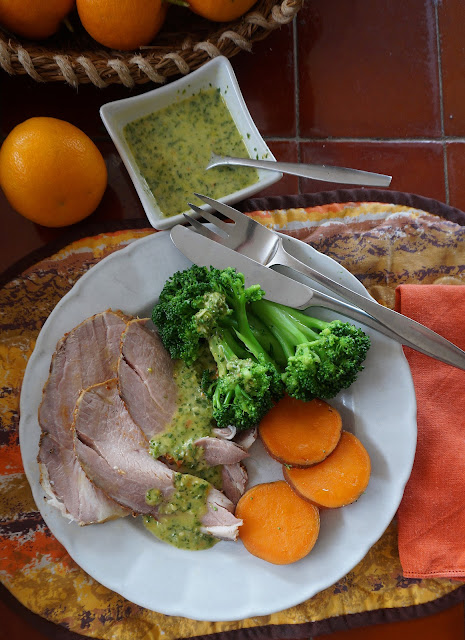Do you ever start out to make one recipe, then change your mind and turn the ingredients into something else altogether? That’s what I did. I picked sour oranges from a tree that’s about to be cut back and grafted to produce sweet eating oranges. I intended to make a traditional fish soup, called cachorreñas.
 |
| Bitter orange tree will be grafted to produce sweet oranges. |
Cachorreña is the local name for the bitter Seville orange, the marmalade orange or bigarade. The peel of the fruit is bitingly bitter; the juice is mouth-puckeringly sour. The bitter orange is used as rootstock for growing sweet oranges and is also grown for its decorative beauty and the heady perfume of orange blossoms in springtime.
I had gotten as far as making the fish stock for the soup, with head, bones and trimmings from fresh hake, with a strip of orange zest, a whole tomato, green pepper and onion. That’s when it occurred to me to make a thick sauce instead of soup. And, instead of cooking the hake fillets in the soup, maybe bake them? Grill? Batter-fried!
 |
| Crisp, beer-battered fried fish is served with sour orange sauce and sweet orange salad on the side. |
In Spain, the bitter oranges are used as an
aliño, dressing, for salads. They can be substituted for sweet oranges in
remojón, orange and cod salad. The juice is added to marinades and meat stews.
Sopa de cachorreñas is a fish soup with sour orange typical of Málaga. In Cádiz a somewhat similar fishermen’s soup is
caldillo de perro, or “dog” soup.
Mayonnaise made with sour orange juice in place of vinegar or lemon is terrific on asparagus or artichokes. The juice is perfect for making Peruvian ceviche, marinated fish. Use it, too, in Persian sweet-sour stews. And, there's always marmalade made with whole, shredded bitter oranges that are exceptionally rich in pectin.
In Spain, bitter orange trees grow in public squares and streets, the fruit free for the picking. Bitter oranges can be found in the US in Latino groceries during winter months. (This is the end of the season.) If not available, I suggest using half white wine vinegar for the sourness, and half sweet orange juice.
Sour Orange Sauce
Salsa de Cachorreñas
 |
| Sour orange juice makes a tangy sauce to serve with fish, shrimp or vegetables such as asparagus. |
This makes a pouring sauce that can be served room temperature. For a thicker, dipping sauce, double the quantity of bread (thickener) and add more salt to season. The sauce is also good with a couple spoonfuls of mayonnaise beaten into it. Try it with shrimp.
Makes 1 cup sauce.
 |
| Bitter peel, sour juice. |
1 tomato
½ green bell pepper
1 small onion
Sprig parsley
1 bay leaf
Water or fish stock
Salt
½ cup packed day-old bread crumbs (1 ounce)
½ teaspoon pimentón (paprika), not smoked
1-2 cloves garlic
½ cup sour orange juice
¼ cup extra virgin olive oil
Dash of hot pepper sauce
1 tablespoon chopped scallions
Place the whole tomato, pepper, onion, parsley and bay leaf in a pan and cover with water or fish stock. Add 1 teaspoon salt. Bring to a boil and cook until the vegetables are very soft, about 15 minutes. Skim out the tomato, pepper and onion and discard the water, parsley and bay.
Place the bread crumbs in a blender. Add the pimentón. Slip the skins off the tomato and pepper and add them to the blender with the onion, garlic and sour orange juice. Blend until smooth. Gradually blend in the oil. Season the sauce with ½ teaspoon salt and a dash of hot pepper sauce. Stir in the chopped scallions.
Serve the sauce at room temperature.
Beer-Battered Fried Fish
Pescado Frito con Rebozado de Cerveza
 |
| Batter-fried fish is crisp on the outside, moist on the inside. |
Use a white fish such as hake, cod, grouper or halibut.
Serves 4.
1 ½ pounds fish fillets
Salt and pepper
1 cup flour
1 teaspoon salt
½ teaspoon baking powder
¾ cup lager beer
Olive oil for frying
Cut the fish in 8 equal-sized pieces and place them on a plate in one layer. Sprinkle them with salt and pepper.
Place 2 tablespoons of the flour in a small bowl. Combine the remaining flour in a bowl with the salt and baking powder. Beat in the beer to make a fairly smooth batter about the consistency of thick cream. Let the batter set 30 minutes.
Pat the pieces of fish with paper towels to absorb excess moisture. Sprinkle the reserved 2 tablespoons of flour on both sides of the fish.
Place oil to a depth of 2 inches in a wide, heavy pan. Heat the oil until it is shimmering (360ºF/ 180ºC). A drop of the batter should immediately sizzle and rise to the top of the oil.
Dip the pieces of fish in the batter, letting excess run off. Place them, a few at a time, in the hot oil. Fry until golden on one side. Carefully turn the fish and fry until golden on reverse side (about 5 minutes total). Remove with a skimmer and place on paper towels to absorb excess oil.
The fish stock I made with orange peel is in the freezer, ready to make the sour orange fish soup on another day.
 |
| Perhaps we should leave one branch of the tree ungrafted. I like having a few sour oranges every year. |












